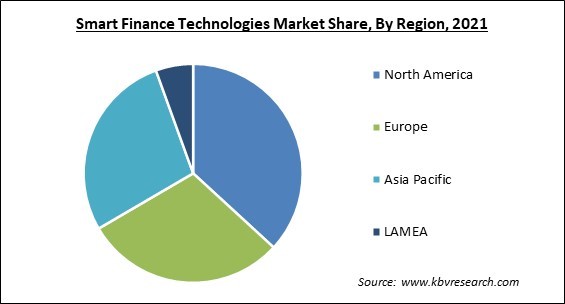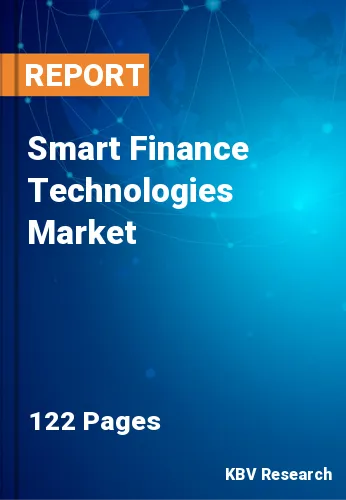The Global Smart Finance Technologies Market size is expected to reach $622.6 million by 2028, rising at a market growth of 4.5% CAGR during the forecast period.
IoT applications in ATMs are among the smart financial technologies. Platforms, hardware, services, and connectivity are all IoT components in ATMs. One of the primary reasons driving market expansion over the projection period is the increasing installation of IoT-based ATMs throughout smart cities. IoT-based ATMs are rapidly being installed at bank sites to provide clients with more convenient financial services. Furthermore, increased technological advancements in IoT linked devices, such as the integration of data analysis tools, are likely to boost market growth throughout the forecast period.
Furthermore, the growing use of next-generation smart ATMs that can be remotely maintained via IoT-connected equipment is fueling the demand for smart finance technology in the banking sector. For example, a Russian bank is preventing ATM fraud by employing Intel RealSense video technology and facial recognition. Moreover, the growing number of ATMs is expected to present a considerable opportunity for the market. According to World Bank data, there were 40.74 ATMs per 100,000 persons worldwide in 2019, increasing to 41.25 ATMs per 100,000 in 2020.
Financial technology is a phrase used to describe the services provided by financial technology organizations. The merger of financial services and information technology is known as financial technology. This integration helps to reshape finance services by making financial activity management simple and smart. Another benefit of this technology is that it enhances the quality of financial services while also lowering overall operational costs, resulting in a more diverse and secure financial landscape.

The COVID-19 pandemic has had drastic effects on the world. The virus caused the deaths of millions of people around the world and destabilized the economic systems of many countries, it also disrupted supply chains. Manufacturing, hospitality, logistics, healthcare, transportation, and retail were all affected by the coronavirus pandemic; however, IT, telecommunications, government, education, energy, and utilities, as well as banking, insurance, and security services, remained relatively unscathed. The COVID-19 outbreak harmed the smart finance technologies market even more because many bank ATMs were closed during the lockdown. The government-mandated lockdowns all over the world limited the number of new ATMs that could have been installed.
Smart contracts are being used by banks to settle the collateral and cash portions of transactions simultaneously. To increase the efficiency and scalability of cross-border sales, transaction processing, securities lending, and equity trades can all be resolved on the blockchain. Meanwhile, using the blockchain to trade securities backed by digital collateral allows for more efficient, transparent, and secure capital management as well as post-transaction equity settlement. Institutional investors are looking for DLT features including tokenization for unlisted companies or private equity funds, spot exchange between established currencies and crypto currencies on digital exchanges, and client custody services like key escrow encryption.
RPA, or robotic process automation, is the most widely utilized tool for automating fixed and repetitive procedures. Automation, unlike AI, relies on a simple set of rules (If this = then that) to provide predictable results. These pre-programmed procedures can handle digitalization, approval, risk flagging, and more using structured data (incoming data on interest charts) or unstructured data (forms filled out by hand). Many also incorporate learning patterns, allowing them to improve over time as more data is collected. RPAs are used to create reports, log data, automate repeated procedures, and keep track of logs.
Government laws and regulations are critical in monitoring and authorizing large-scale technology adoption, particularly in the financial industry, which has a big consumer base. Since centralized systems have enveloped the financial sector for decades, a rapid transition to decentralized networks using blockchain technology will almost certainly necessitate regulatory compliance. All technology suppliers must adhere to data privacy rules, which vary by country. Some countries, such as China, Australia, and Japan, have rigorous regulatory frameworks for blockchain technology. Regulatory policies are thus expected to stifle global blockchain technology market growth in the coming years.

Based on Type, the market is segmented into Smart Finance Platforms, Smart Finance Connectivity, Smart Finance Hardware, and Smart Finance Services. The smart finance platforms segment acquired the largest revenue share in the smart finance technologies market in 2021. The expanding trend toward the implementation of smart ATMs on bank premises around the world is driving this segment's growth. Improved security measures, including biometric and IoT services to prevent fraud, as well as the introduction of smart ATMs for clients with specialized needs, are all helping to propel this segment forward. Furthermore, the segment's expansion was aided by significant growth in the BFSI industry, as well as the adoption of advanced ATMs in developing economies. As technology progresses, customers are opting for safe, convenient, and trustworthy methods of obtaining cash, supporting the growing usage of smart finance platforms around the world.
| Report Attribute | Details |
|---|---|
| Market size value in 2021 | USD 466 Million |
| Market size forecast in 2028 | USD 622.6 Million |
| Base Year | 2021 |
| Historical Period | 2018 to 2020 |
| Forecast Period | 2022 to 2028 |
| Revenue Growth Rate | CAGR of 4.5% from 2022 to 2028 |
| Number of Pages | 125 |
| Number of Tables | 180 |
| Report coverage | Market Trends, Revenue Estimation and Forecast, Segmentation Analysis, Regional and Country Breakdown, Companies Strategic Developments, Company Profiling |
| Segments covered | Type, Region |
| Country scope | US, Canada, Mexico, Germany, UK, France, Russia, Spain, Italy, China, Japan, India, South Korea, Singapore, Malaysia, Brazil, Argentina, UAE, Saudi Arabia, South Africa, Nigeria |
| Growth Drivers |
|
| Restraints |
|
Based on Regions, the market is segmented into North America, Europe, Asia Pacific, and Latin America, Middle East & Africa. North America acquired the largest revenue share in the smart finance technologies market in 2021. One of the key factors for smart finance technologies market expansion in this region is the presence of well-established industry players such as Intel Corp., Diebold Nixdorf, Microchip Technology Inc., and others. Furthermore, the market share was boosted by major investments in smart infrastructure and the availability of a large number of safe internet servers. Moreover, the region's developed IT infrastructure makes it easier to implement IoT-based devices in the BFSI sector, such as smart ATMs, contributing to the region's considerable share in the smart finance technologies market. Furthermore, market growth in the region may be ascribed to innovations in IoT applications and the introduction of new smart gadgets.
Free Valuable Insights: Global Smart Finance Technologies Market size to reach USD 622.6 Million by 2028
The market research report covers the analysis of key stake holders of the market. Key companies profiled in the report include Intel Corporation, Fujitsu Limited, Diebold Nixdorf, Inc., IMS Evolve, Miles Technologies, Inc., Zicom SaaS Pvt. Ltd., Zoho Corporation Pvt. ltd., GRGBanking Equipment Co., Ltd., Dialog Axiata PLC, and Virtusa Corporation.
By Type
By Geography
The global smart finance technologies market size is expected to reach $622.6 million by 2028.
Real-time transaction settlement are driving the market in coming years, however, stringent government regulations on block chain-related transactions growth of the market.
Intel Corporation, Fujitsu Limited, Diebold Nixdorf, Inc., IMS Evolve, Miles Technologies, Inc., Zicom SaaS Pvt. Ltd., Zoho Corporation Pvt. ltd., GRGBanking Equipment Co., Ltd., Dialog Axiata PLC, and Virtusa Corporation.
The expected CAGR of the smart finance technologies market is 4.5% from 2022 to 2028.
The North America is the fastest growing region in the Global Smart Finance Technologies Market by Region in 2021.
Our team of dedicated experts can provide you with attractive expansion opportunities for your business.

